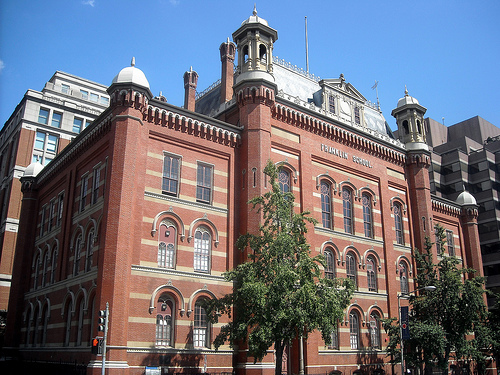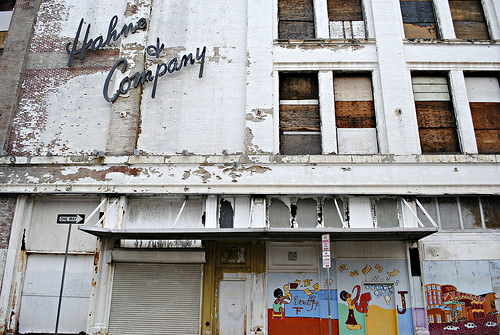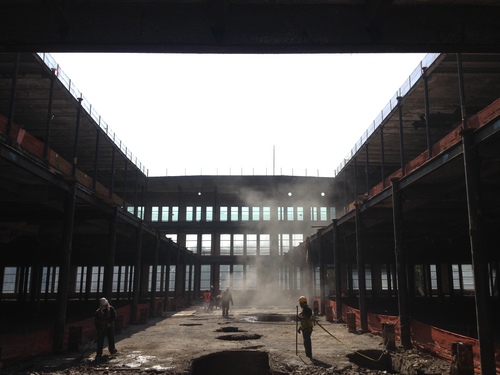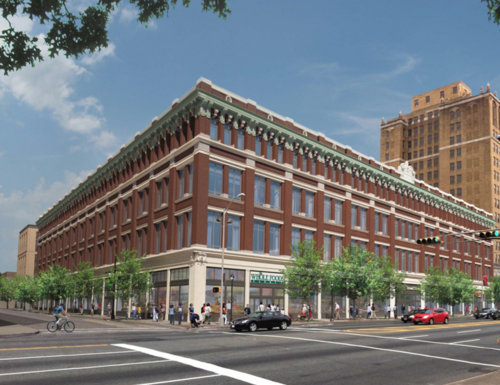To get ideas for reusing the historic Franklin School building, DC can look to Newark, NJ
The Franklin School, at 13th and K NW, is an iconic DC building, but it has been vacant and abandoned since 2008. On a recent trip to Newark, New Jersey, I got a glimpse of another use for old, historic buildings.
Designed and built in the 1860s by Adolph Cluss, who also designed Eastern Market on Capitol Hill, the Franklin building has a Great Hall that could seat 1,000. It was the centerpiece for DC’s public education system— its big windows for light, along with roomy and airy spaces, made for a great learning environment— as well as a resource for community concerts, exhibitions, and public meetings.
Before being abandoned, the building most recently served as a homeless shelter. Mayor Vincent Gray pushed to renovate it, but when Mayor Muriel Bowser became mayer she reversed course and put the proposals on hold. Though Bowser solicited new proposals in October 2015, she has not provided any timeline for review and decision making.
Throughout the 2000s, the DC Council had multiple opportunities to make the building eligible to lease or sell but failed to do so. A 2005 deal to turn Franklin School into a hotel fell through because the proposed lease wasn’t valid, and the discussion over what to do with the building has been plagued by a lack of focus, transparency, and analysis of redevelopment options, the kind of thing that can keep proposals with a lot of merit from ever even coming forward.
It’s not as if we don’t know how to preserve important historic structures. It took just two years after a 2007 fire at Eastern Market for the neighborhood jewel to reopen: Local firm Quinn Evans Architects replaced the roof while retaining many of the original iron trusses, and added sustainability features including high-efficiency lighting and HVAC systems, high-performance glazing, and stormwater filtration.
Thinking creatively about place, the built environment, and the long-term prosperity of residents is an essential task for every city and town.
So why have we struggled with the Franklin building so much?
Here’s what Newark did with its equivalent of the Franklin School building
If I could, I’d take some of DC’s leaders on a field trip to Newark, New Jersey to visit the Hahne & Company department store building.
There, a truly collaborative effort between the City of Newark, Rutgers University - Newark, L & M Development, and J. P. Morgan Chase has resulted in an old icon (a former star of local retail, it’s been in disrepair for 30 years) becoming the centerpiece of Newark’s recovering downtown.
During a hardhat tour of the renovation ($174 million, 400,000 sq. ft.), the development team highlighted the future for the building. By December 2016, the mixed use, mixed-income space will be open to its first residents. A total of 161 rental units, 60 percent market rate and 40 percent for low income residents (at 60 percent of area median income), will be ready.
The retail floors, with anchor tenant Whole Foods, will open this spring. Rutgers University - Newark will house their Department of Arts, Culture, and Media there, which will include classrooms, artist studios and gallery space. The project has put nearly every relevant tax credit to use — historic preservation, new markets, and low income housing. For the coup de grace, the great skylight — 4-stories above the central atrium — is being meticulously restored to its former glory.
As it turns out, Newark is a hotbed of preservation and reuse. Not far from the Hahne building, a similar coalition is nearly finished renovating the former American Insurance Company tower into a building that will have both retail and residential uses. When it comes to historic preservation, partnerships across sectors, and creating new housing, these projects are transformative.
In Newark, preservationists and other key stakeholders are taking full advantage of the assets they have available — 60 to 100 years of growth in the built environment that yielded homes, factories, shopping arcades, warehouses, transportation systems, public utilities, parks, schools, and neighborhood residents.
Although simple economic arithmetic may dictate demolition and abandonment, those willing to see beyond the next fiscal quarter tend to reap far greater rewards. It is for this reason, for the creation of a more prosperous and distinctive place — a place that people want to live in or go to rather than drive through — that historic preservation needs to be an essential strategy for every city and town. In the nation’s capital, we have plenty of opportunities to apply these lessons.




